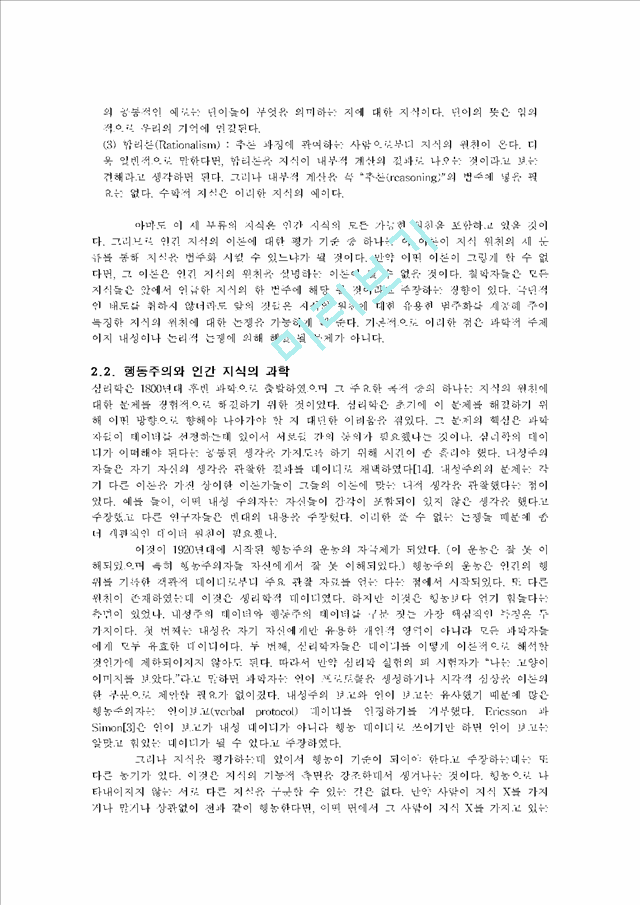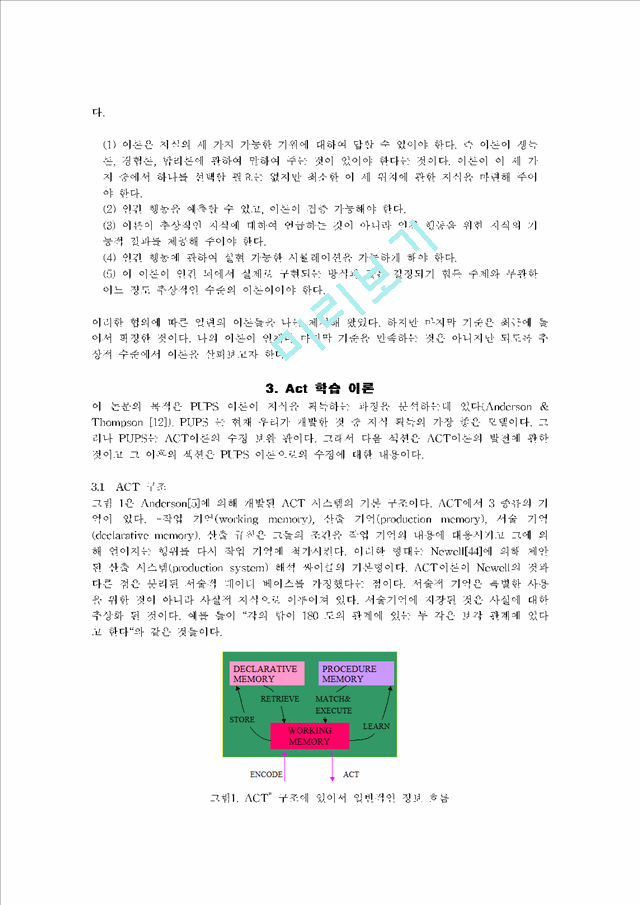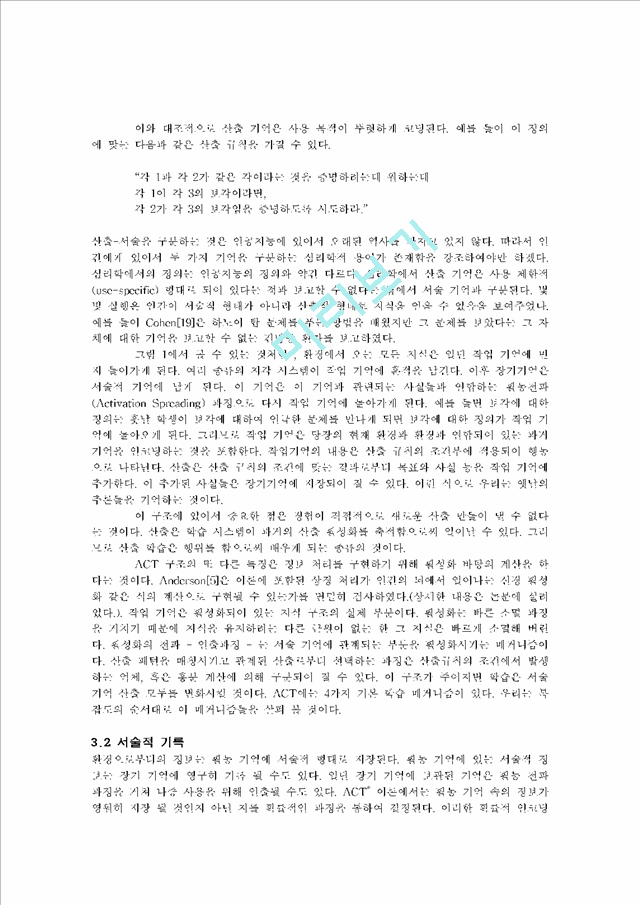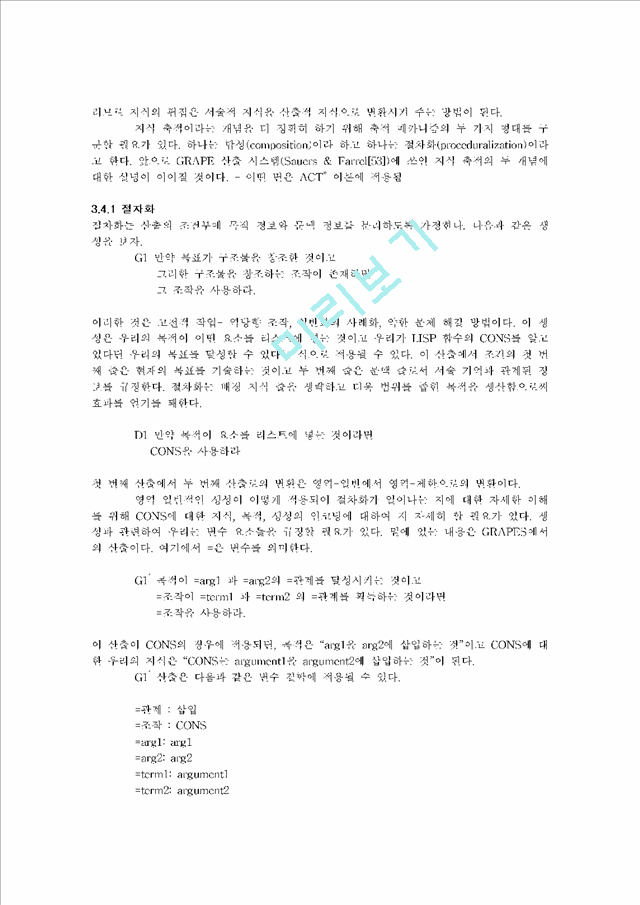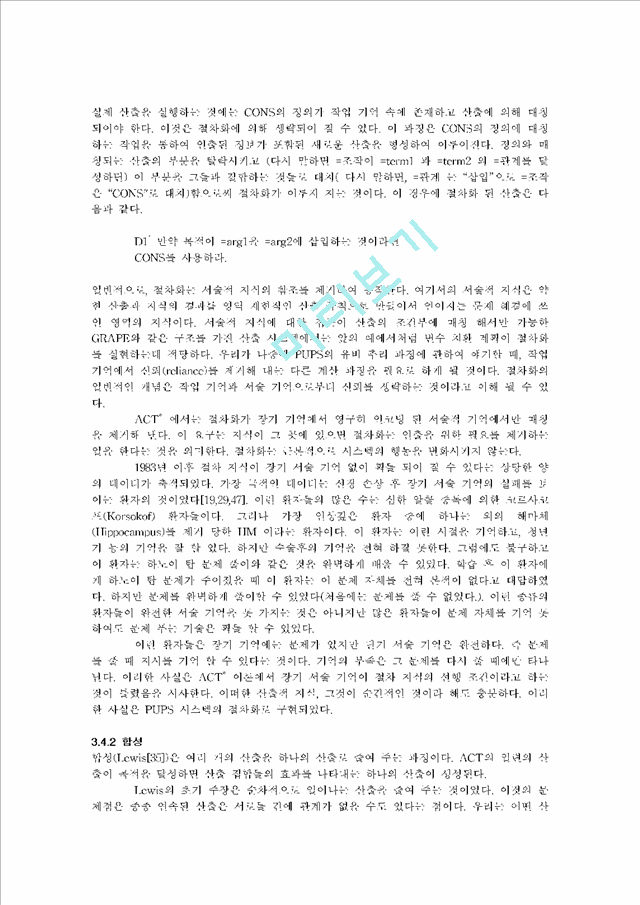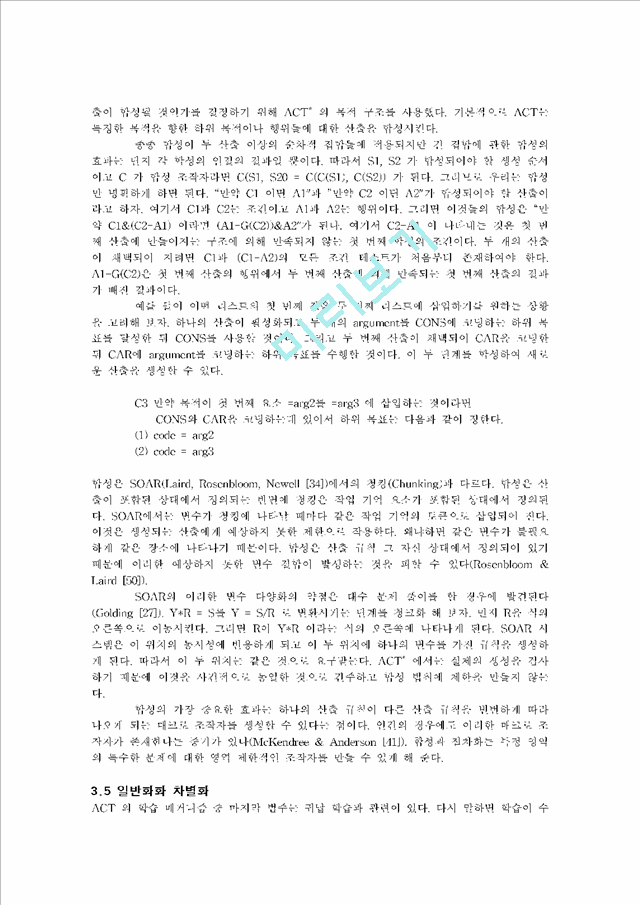| |
|
|
A Theory of the Origins of Human Knowledge |
|
|
네이버 ID로 다운 받기 카카오 ID로 다운 받기 구글 ID로 다운 받기 페이스북 ID로 다운 받기 |
| 자료설명 |
|
4.7 차별화 PUPS 의 유비 추리는 ACT* 이론의 일반화를 대치시키기 위해 고안되었다. 산출 규칙을 생성하기 위해 유비 추리를 편집하는 ... |
| 본문/내용 |
|
4.7 차별화
PUPS 의 유비 추리는 ACT* 이론의 일반화를 대치시키기 위해 고안되었다. 산출 규칙을 생성하기 위해 유비 추리를 편집하는 것은 일반화에 해당된다. ACT* 에서처럼, 일반화에 알맞은 제한을 첨가하는 보조적인 차별화 메커니즘이 필요하다. PUPS 구조의 선행 조건 슬롯은 기능을 달성하는데 실패할 때 결정적인 선행조건이 빠져서 이러한 현상이 발생한 것으로 보고 선행조건을 찾아서 PUPS 구조에 인코딩 한다. 현재는 이러한 선행조건이 더해지는 방식이 두 가지가 있다. 선행조건에 대한 정보가 서술적 구조로 되어 있기 때문에, 정보는 언 어의 형태나 산출 행위의 출력 형태로 인코딩 된다. 다른 식으로 PUPS는 ACT* 에서처럼 성공된 유비 추리와 실패한 유비 추리 사이의 결정적인 차이를 찾는 방식으로 비교하기도 한다. Sharger의 상황(그림2)처럼 잘못된 유비 추리에 적용되면 발견되지 못한 차이는 왼쪽이나 오른쪽으로 탱크를 회전하도록 하는 것이다. 그러나 PUPS 가 이 수행을 했을 때 ACT* 와 달리 선행조건이 서술적 데이터 구조로 덧 붙여져서 검사에 유용해 진다. 이런 과정은 특징의 차이점을 말로 표현했을 때 피험자가 성공적인 차별화…(생략) |
| 참고문헌 |
|
1. Anderson J.A., A theory for the recognition of items from short memorized lists, Phychol.Rev 80(1973) 417-438. 2. Anderson. J.R., Language, Memory, and Thought (Erlbaum, Hillsdale, NJ, 1976). 3. Anderson. J.R., Tuning of search of the problem space for geometry proofs, in: Proceedings IJCAI-8I, Vancouver, BC (1981). 4. Anderson. J.R., Acquisition of cognitive skill, Psychol. Rev 89 (19822) 369-406. 5. Anderson, J R., The Architecture of Cognition (Harvard University Press, Cambridge, MA, 1983). 6. Anderson, J.R., A rational analysis of human memory, in: H.L. Roediger III and F.I.M, Craik (Eds.), Varieties of Memory and Consciousness: Essays in Honor of Endel Tulving (Erlbaum, Hillsdale, NJ, 1988). 7. Anderson, J.R. Causal analysis and inductive learning, in: Proceedings Fourth International Workshop of Machine Learning, Irvine, CA (1987). 8. Anderson, J.R., Methodologies for studying human knowledge, Behav. Brain Sci. (to appear). 9. Anderson, J.R. and Bower, G.H., Human Associative Memory (Winston and Sons, Washington, DC, 1973). 10. Anderson, J.R., Farrell, R. and Sauers, R., Learning to program in LISP, Cognitive Sci. 8(1984) 87-129. 11 Anderson, J.R. and Jeffries, R., Novice LISP errors: Undetected losses of information from working memory, Hum.-Comput. Interaction 22 (1985) 403-423. 12. Anderson, J.R. and Thompson, R , Use of analogy in a production system architecture, in: A. Ortony et al. (Eds.), Similarity and Analogy (to appear) 13. Atkinson, R. and Shiffrin, R., Human memory: A proposed system and its control processes, in: K. Spence and J. Spence (Eds.), The Psychology of Learning and Motivation (Academic Press, New York, 1968). 14. Boring, E.G., History of Experimental Psychology (Appleton-Century-Crofts, New York, 1950). 15. Bower, G.H, and Hilgard, E.K., Theories of Learning (Prentice-Hall, Englewood Cliffs, NJ, 198l). 16. Carbonell, J.G.. Derivational analogy: A theory of reconstructive problem solving and expertise acquisition, Tech. Rept. 85-115, Department of Computer Science, Carnegie-Mellon University, Pittsburgh, PA (1985). 17 Chomsky, N., Verbal Behavior (A review of Skinner`s book), Language 35 (1959) 26-58, 18. Chomsky, N., The formal nature of language, in: E.H. Lenneberg (Ed.), Biological Foundation of Language (Wiley, New York, 1967) Appendix A 19. Cohen, N.J, Preserved learning capacity In amnesia: Evidence for multiple memory systems, in: L.R. Squire and N. Bailers (Eds.), Neuropsychology of Memory (Guilford, New York, 1984), 20. Crowder, R G., The demise of short-term meory, Acta Psychol. 50 (1982) 291-323. 21. DeJong, G., Generalizations based on explanations, in: Proceedings IJCAI-81, Vancouver, BC (1981) 22. Dietterich, T.G., Learning at the knowledge level, Mach. Learning 1 (1986) 287-316. 23. Dulany, D.E., Carlson, R.A. and Dewey, G.I., A case of syntactical learning and judgment: How conscious and how abstract?, J. Experimental Psychol. Ceneral 113 (1984) 541-5,55. 24. Elio, R. and Anderson, J.R., Effects of category generalizations and instance similarity on schema abstraction, J. Experimental Psychol. Learning, Memory Cognition 7 (1983) 397-417. 25. Ericsson, K.A. and Simon, H.A., Protocol Annlysis: Verbal Reports as Data (MIT Press, Cambridge, MA, 1984). 26. Gentner, D., Structure-mapping: A theoretical framework for analogy, Cognitive Sci. 7 (1983) 155-170. 27. Golding, A., Analogical problem solving in SOAR, Unpublished Manuscript, Stanford University, Stanford, CA (1985). 28. Hayes-Roth, F. and McDermott, J., Learning structured patterns from examples, in: Proceedings Third International Joint Conference on Patterern Recognition, Coronado, CA (1976) 419-423. 29. Jacoby, L.L., and Witherspoon, D., Remembering without awareness, Can, J. Psychol. 36(1982) 300-324. 30. Just, M.A. and Carpenter, P.A., The computer and eye processing pictures, Behav. Res. Methods Instrumentation 11(1979) 172-I76 31. Kedar-Cabelli. S., Purpose-directed analogy, in: Proceedings Seventh annual Conference of the Cognitive Science Society, Irvine, CA (1985). 32. Kieras, D. E. and Bavoir. S., The acquisition of procedures from text: A production-system analysis of transfer of training, J. Memory Lang. 25 (1986) 33. Kline. PJ. Computing the simularity of structured objects by means of heuristic search for correspondence. Unpublished Doctoral Dissertation, University of Michigan, Ann Arbor, MI(1983) 34. Laird, J.E., Rosenbloom, P.S. and Newell. A.. Chunking in SOAR: The anatomy of general learning mechanism. Mach. Learning 1 (1986) 11-46 35. Leweis, C.H., Production system model of practice effects, Doctoral Dissertation, University of Michigan. Ann Arhor. M1 (1978). 36. Lewis. C.H.. Understanding what`s happening in system interactions, in: D.A. Norman and S.W. Daper (Eds.). User Centered System Design: New Perspectives in Human-Computer Interaction(Erlbaum. Hillsdale, NJ, 1986) 37. Lewis. MW. and Anderson, J.R., Discrimination of operator schemata in problem solving: Learning from example. Cognitive Psychol. 17 (1985) 26-65. 38. Luchins, A.S., Hechanization in Problem Solving, Psychological Monographs 54 (248) (1942) 39. Marr, D., Vision (Freeman, San Francisco, CA, 1982). 40. McClelland. Rumelhart, D.E. and the PDP, Research Group, Parallel Distributed Processing: Explorations in the Microstructure of Cognition, II: Applications (MIT, Cambridge. MA. 1986) 41. McKendree. J E. ancf Anderson, J.R., Frequency and practice effects on the composition of knowledge in LISP evaluation. in: J.M. Carroll (Ed.). Cognitive Aspects of Human-Computer Intercation (to appear). 42. Mitchell, T.M., Version spaces: An approach to concept learning, Doctoral Dissertation, Department of Electrical Engineering, Stanford Universtiy, Standofrd, CA(1978). 43. Mitchell, T.M., Keller, R.M. and Kedar-Cabelli, S.T., Explanation-based generalization: A unifying view, Mach. Learning 1 (1986) 47-80. 44. Newell. A., A theoretical exploration of mechanisms for coding the stimulus, in: A.W. Melton., and E. Martin (Eds.). Coding Processes in Human Memory (Winston, Washington, DC, 1972). 45. Newell, A., The knolwledge level, AI Mag. 2 (1981) 1-20. 46. Newell. A. and Simon, H. Human Problem Solving (Prentice-Hall, Enelewood Cliffs, NJ, l972). 47. Nissen. M.J and Bullemer, P., Attentional requirements of learning: Evidence from performance measures (to appear), 48. Pirolli. P.L., Problem solving by analohy and skill acquisition in the domain of programming, Master`s Thesis. Carnegie-Mellon University, Pittsburgh, PA (1985). 49. Reher, A.S., Implicit learning of synthetic languages: The role of instructional set, J. Experimental Psychol. Hum. Learning Memory 2 (1976) 88-94. 50. Rosenbloom, P.S. and Laird. J.E., Explanation-based generalization in SOAR, in: Proceedings AAAI-86. Philadelphia. PA (1986) 561-567. 51. Ross. B.H., Remindings and their effects in learning in cognitive skill, Cognitive Psychol. 16 (1984) 371-416. 52. Rumelhart, D.E., McClelland, J.L. and the PDP Research Group, Parallel Disributed Processing: Exploration in the Microstucture of Cognition, I: Foundations (MIT, Cambridge, MA. 1986). 53. Sauers, R. and Farrell, R., GRAPES user`s manual, Tech. Rept. 1, Department of Psychology, Carnegie-Mellon University, Pittsburgh, PA (1982). 54. Shrager, J.C., Instructionless learning: Discovery of the mental device of a complex model, Doctoral Dissertation, Department of Psychology, Carnegie-Mellon University, Pittsburgh, PA (1985). 55. Skinner, B.F., Verbal Behavior (Appleton-Century-Croft , New York, 1957). 56. Sternberg, S., Memory scanning: Mental processes revealed by reaction time experiments, Am.Sci. 57 (1969) 421-453. 57. Townsend, J.T., Issues and models concerning the processing of a finite number of inputs, in B.H. Kantowitz (Ed.), Human Information Processing: Tutorials in Performance and Cogntion (Erlbaum, Willsdale, NJ, 1974). 58. Vere, S.A., Induction of relational productions In the presence of background information Procedings IJCAI-77, Cabridge, MA (1977) 349-355, 59. Wickelgren, W.A., Single-trace fragility theory of memory dynamics, Memory Cognition 2 (1974)775-780. 60. Winston, P.H.. Binford. T.O., Katz, B. and Lowry, M., Learning physical descriptions from functional definitions, examples, and precedents, in: Proceedings AAAI-83, Washington, DC (1983). |
보관중인 자료가 없습니다
| 자료정보 |
|
ID : gtdw***** Regist : 2014-10-20 Update : 2014-10-20 FileNo : 16059338 |
|
| |

| |
| 연관검색(#) |
| The the Origins Human Knowledge |
|
회사소개 |
이용약관 |
개인정보취급방침 |
고객센터 ㅣ
olle@olleSoft.co.kr
올레소프트 | 사업자 : 408-04-51642 ㅣ 광주광역시 광산구 무진대로 326-6, 201호 | 채희준 | 통신 : 광산0561호 Copyrightⓒ 올레소프트 All rights reserved | Tel.070-8744-9518 |
















